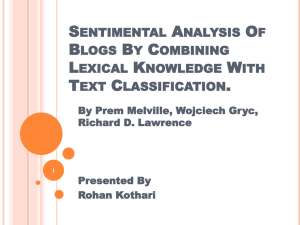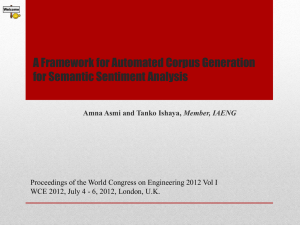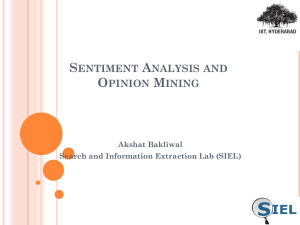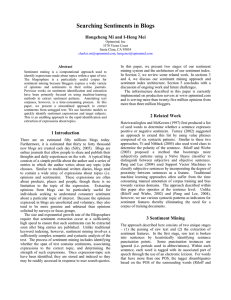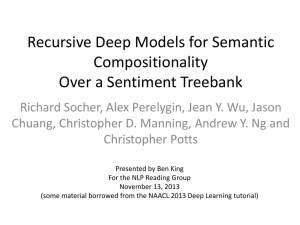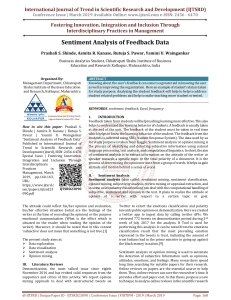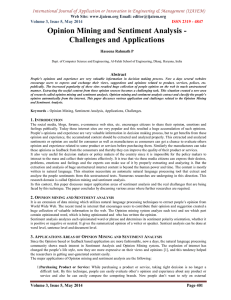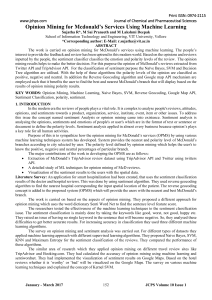New Avenues in Opinion Mining and Sentiment Analysis
advertisement
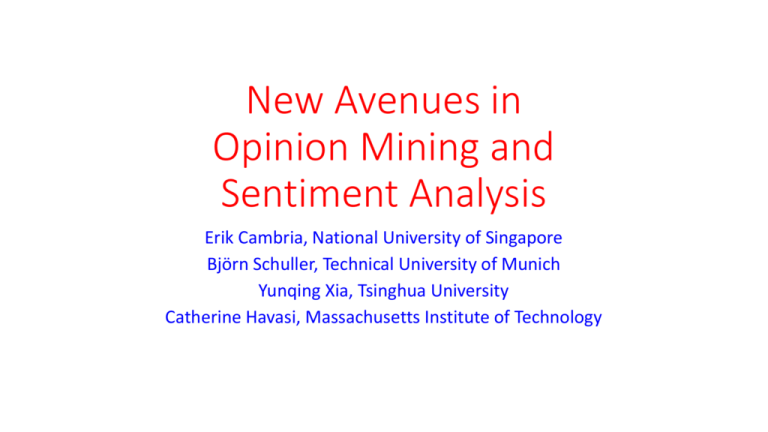
New Avenues in Opinion Mining and Sentiment Analysis Erik Cambria, National University of Singapore Björn Schuller, Technical University of Munich Yunqing Xia, Tsinghua University Catherine Havasi, Massachusetts Institute of Technology Introduction • Others’ opinions can be crucial when it’s time to make a decision or choose among multiple options. • When those choices involve valuable resources (e.g., spending time and money to buy products or services) people often rely on their peers’ past experiences. • The “social web” provides new tools to efficiently create and share ideas with everyone connected to the World Wide Web. Introduction • Capturing public opinion about social events, political movements, company strategies, marketing campaigns, and product preferences is garnering increasing interest from the scientific community (for the exciting open challenges), and from the business world (for the economic benefits). • This information is unstructured; however, and because it is produced for human consumption, it is not something that is “machine processable.” • The resulting emerging fields are opinion mining and sentiment analysis. Introduction • Although commonly used interchangeably to denote the same field of study, opinion mining and sentiment analysis actually focus on polarity detection and emotion recognition, respectively. • Both fields use data mining and natural language processing (NLP) techniques to discover, retrieve, and distill information and opinions. Introduction • Mining opinions and sentiments from natural language is challenging, because it requires a deep understanding of the explicit and implicit, regular and irregular, and syntactical and semantic language rules. • Sentiment analysis researchers struggle with NLP’s unresolved problems: coreference resolution, negation handling, anaphora resolution, named-entity recognition, and word-sense disambiguation, among others. Introduction • Coreference, e.g., occurs when two or more expressions in a text refer to the same entity; e.g., in “Bill said he would come”; the proper noun Bill and the pronoun he refer to the same person, namely to Bill. • An anaphora is the use of an expression which depends specifically upon an antecedent expression, and thus is contrasted with cataphora. e.g., in “Sally arrived, but nobody saw her”, the pronoun her is an anaphor, referring back to the antecedent Sally. In “Before her arrival, nobody saw Sally”, the pronoun her refers forward to the postcedent Sally, so her is now a cataphor. Introduction • Named-entity recognition is a subtask of information extraction that seeks to locate and classify elements in text into pre-defined categories such as the names of persons, organizations, locations, expressions of times, quantities, monetary values, percentages, etc. • Example: Jim bought 300 shares of Acme Corp. in 2006. Output: [Jim]Person bought 300 shares of [Acme Corp.]Organization in [2006]Time. Introduction • Opinion mining is a very restricted NLP problem, because the system only needs to understand the positive or negative sentiments of each sentence and the target entities or topics. • This is an opportunity to make tangible progress on all fronts of NLP, and potentially have a huge practical impact. Introduction Opinion mining can help: • To create and automatically maintain review and opinion-aggregation websites. • To improve customer relationship management and recommendation systems through positive and negative customer feedback. • To detect and exclude “flames” (overly heated or antagonistic language) in social communication and enhance antispam systems. • To develop marketing strategies by assessing and predicting public attitudes toward their Brand. Introduction • Research and development focuses on designing automatic tools that crawl online reviews and condense the information gathered. • Most existing tools and research, however, are limited to polarity evaluation or mood classification according to a limited set of emotions. • Such methods mainly rely on parts of text in which people explicitly express emotional states, and therefore the tools can’t capture a reviewer’s implicitly expressed opinion or sentiment. Introduction • The basic task of opinion mining is polarity classification. • Polarity classification occurs when a piece of text stating an opinion on a single issue is classified as one of two opposing sentiments. • Reviews such as “thumbs up” versus “thumbs down” or “like” versus “dislike” are examples of polarity classification. Introduction • Typically, a system performs sentiment analysis over on-topic documents. • However, a document’s off-topic passages might contain irrelevant affective information and create inaccurate global sentiment polarity about the main topic. • Also, a document might contain information on multiple topics that interest the user. • In such instances, it is important to identify topics and separate the opinions associated with each topic. Introduction • Some methods rely on the distance between terms. • General textual analysis uses part of speech (POS) information (e.g., nouns, adjectives, adverbs, and verbs). • Certain adjectives are good indicators of sentiment and guide feature selection to classify the sentiment. Introduction • Recent studies emphasize the importance of position in sentiment summarization. • For example, the incipits of articles in topic-based summarization usually indicate the text’s sentiment. However, the last n sentences of a product review often best summarize the document’s overall sentiment. From Coarse- to Fine-Grained Analysis • Early on, researchers classified entire documents by overall positive or negative polarity, and also by rating scores of reviews. • These documents were mainly supervised, such as movie or product reviews explicitly indicating an overall positive or negative opinion. • However, opinions and sentiments do not occur only at the document level, nor are they limited to a single valence or target. • One document might contain positive and negative opinions toward one or more topics. From Coarse- to Fine-Grained Analysis • Some researchers have reduced text-analysis granularity to the sentence level. • Reviewers tend to adhere to being either subjective or objective, and that creates continuity among adjacent sentences. • But even sentence-level approaches often fail to discover sentiments about an entity and/or its aspects. From Coarse- to Fine-Grained Analysis • To correct that, other researchers adopted an aspect-level approach, wherein an opinion consists of targets and the sentiments associated with them. • For example, the sentence “the new iPhone 5’s screen size is amazing, but its battery life is short” evaluates two aspects (opinion targets): the screen size and battery life of the same entity. The sentiment about the iPhone 5’s screen size is positive, but the sentiment about its battery life is negative. A classification of the existing approaches • Keyword spotting. Although the most naïve approach, keyword spotting’s accessibility and economy make it popular. • This approach classifies text by affect categories based on the presence of unambiguous affect words such as happy, sad, afraid, and bored and intensity modifiers (extremely, very, mildly, etc.) • Keyword spotting is weak in two areas: it can not reliably recognize affect negated words, and it relies on surface features. A classification of the existing approaches • Negated words: Example: “today was a happy day” and “today wasn’t a happy day at all” would be likely considered affectively positive by this approach. • Surface features: Sometimes, a sentence conveys affect through underlying meaning rather than affect adjectives. Example “My husband just filed for divorce and he wants to take custody of my children away from me” evokes strong emotions, but uses no affect keywords. A classification of the existing approaches • Lexical affinity. This approach not only detects obvious affect words, it also assigns arbitrary words a probable “affinity” to particular emotions. • For example, lexical affinity might assign the word “accident” a 75percent probability of indicating a negative affect, as in “car accident” or “hurt by accident.” A classification of the existing approaches • Although it often outperforms pure keyword spotting, there are two main problems with this approach. • First, negated sentences (I avoided an accident) and sentences with other meanings (I met my girlfriend by accident) trick lexical affinity, because they operate solely on the word level. • Second, lexical affinity probabilities are often biased toward text of a particular genre, dictated by the linguistic corpora’s source. This makes it difficult to develop a reusable, domain-independent model. A classification of the existing approaches • Statistical methods. This approach, which includes support vector machines, is popular for affect text classification. • By feeding a machine-learning algorithm with a large training corpus of affectively annotated texts, the system might learn the affective valence of affect keywords • Generally, statistical methods are semantically weak, which means that individually—with the exception of obvious affect keywords—a statistical model’s other lexical or co-occurrence elements have little predictive value. A classification of the existing approaches • Concept-based approaches. These methods use Web ontologies or semantic networks to accomplish semantic text analysis. • By relying on large semantic knowledge bases, such approaches step away from blindly using keywords and word co-occurrence counts, and instead rely on the implicit meaning/features associated with natural language concepts. A classification of the existing approaches • Concept-based approaches can detect subtly expressed sentiments and can analyze multi-word expressions that do not explicitly convey emotion, but are related to concepts that do. • Drawback: The concept-based approach relies heavily on the depth and breadth of the knowledge bases it uses, without it an opinionmining system will have difficulty grasping the semantics of natural language text. Future work • Many new areas might be useful in opinion mining, such as facial expression, body movement, or a video blogger’s choice of music or color filters. • There’s almost no research that focuses on multimodal sentiment and opinion analysis: analyze smiles, gazes, pauses, and voice pitch among othes aspects. • More accurated methods to detect, perceive, and “feeling” emotions. Discussion • Rather than gathering isolated opinions about a whole item, users generally prefer to compare specific features of different products (e.g., the iPhone 5 versus the Galaxy S3 touchscreen) or even subfeatures (comparing the fragility of iPhone 5 and Galaxy S3 touchscreens). Discussion • Deconstructing natural language text into sentiments considering contexts (context-intent level analysis) • For example, in appraising the concept “small room” as negative for a hotel review and “small queue” as positive for a post office, or the concept “go read the book” as positive for a book review but negative for a movie review. Discussion • The Web has changed from “read only” to “read-write”. • Despite significant progress, however, opinion mining and sentiment analysis are still finding their own voice as new interdisciplinary fields. • Recent approaches aim to better grasp the conceptual rules that govern sentiment. • More complete knowledge must be combined with reasoning methods that are more deeply inspired by human thought and psychology.

